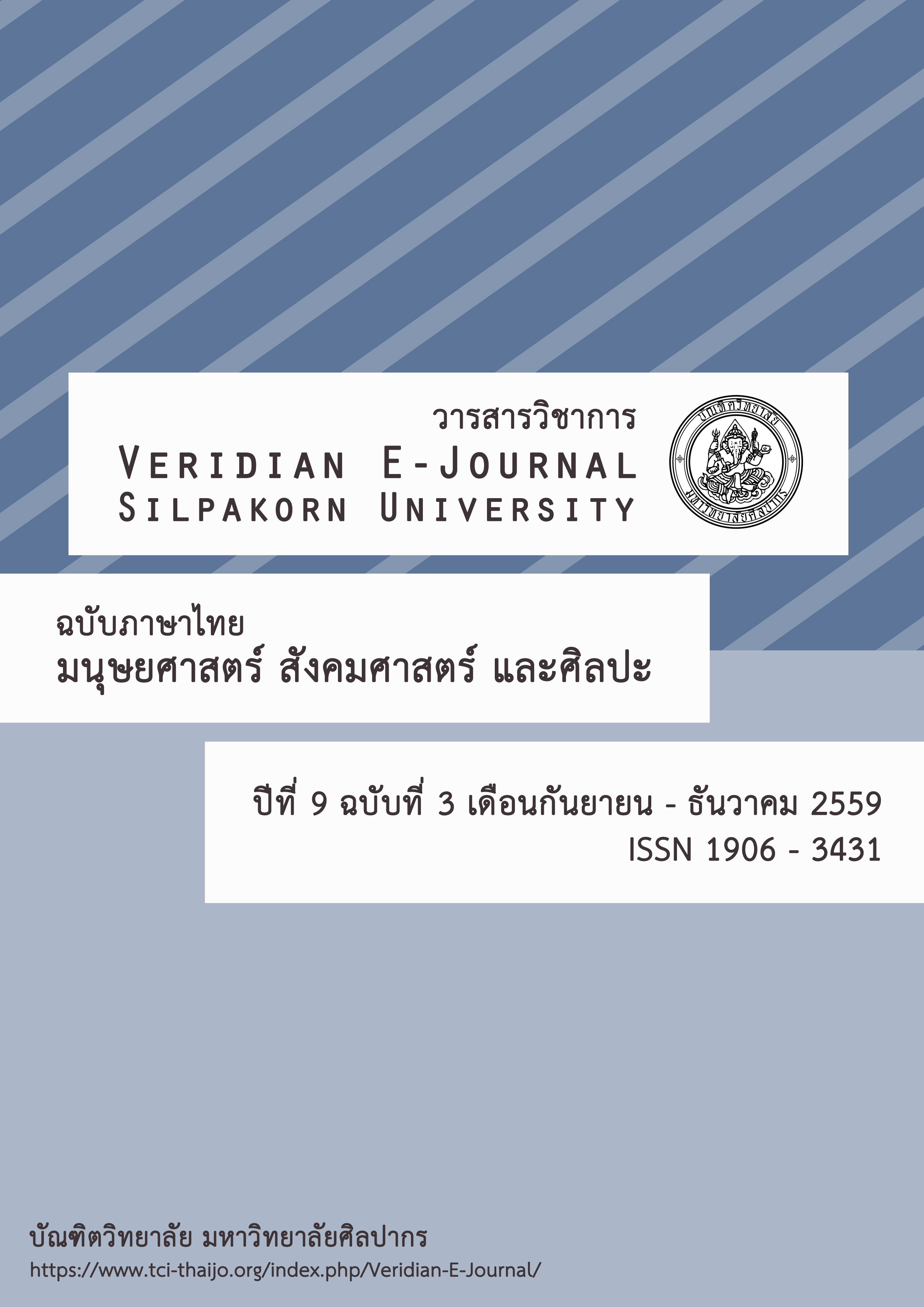การพัฒนาบทเรียนคอมพิวเตอร์ช่วยสอนคำศัพท์ภาษาอังกฤษสำหรับนักเรียนชั้นมัธยมศึกษา ปีที่ 3 โรงเรียนชลบุรี "สุขบท"
Main Article Content
Abstract
การวิจัยครั้งนี้มีวัตถุประสงค์เพื่อ 1) พัฒนาและหาประสิทธิภาพของบทเรียนคอมพิวเตอร์ช่วยสอนคำศัพท์ภาษาอังกฤษ 2) เปรียบเทียบความสามารถด้านคำศัพท์ภาษาอังกฤษก่อนและหลังเรียนด้วยบทเรียนคอมพิวเตอร์ช่วยสอนคำศัพท์ภาษาอังกฤษ ที่ผู้วิจัยสร้างขึ้น และ 3) ศึกษาความคิดเห็นของนักเรียนที่มีต่อบทเรียนคอมพิวเตอร์ช่วยสอนคำศัพท์ภาษาอังกฤษ ที่ผู้วิจัยสร้างขึ้น กลุ่มตัวอย่างคือนักเรียนชั้นมัธยมศึกษาปีที่ 3 โรงเรียนชลบุรี "สุขบท" ในภาคเรียนที่ 2 ปีการศึกษา 2558 ได้มาจากการสุ่มตัวอย่างแบบเจาะจง (purposive sampling) 1 ห้องเรียน ได้นักเรียนจำนวน 40 คน เครื่องมือที่ใช้ในการวิจัยประกอบด้วย 1) บทเรียนคอมพิวเตอร์ช่วยสอนคำศัพท์ภาษาอังกฤษ 2) แบบทดสอบความสามารถทางด้านคำศัพท์ภาษาอังกฤษ 3) แบบสอบถามความคิดเห็นต่อบทเรียนคอมพิวเตอร์ช่วยสอน ที่ผู้วิจัยสร้างขึ้น การวิเคราะห์ข้อมูลใช้สถิติ t-test เพื่อเปรียบเทียบความสามารถทางด้านคำศัพท์ภาษาอังกฤษของกลุ่มตัวอย่างก่อนและหลังเรียนด้วยบทเรียนคอมพิวเตอร์ช่วยสอน และใช้ค่าเฉลี่ยส่วนเบี่ยงเบนมาตรฐานในการหาค่าระดับความคิดเห็นต่อบทเรียนคอมพิวเตอร์ช่วยสอนคำศัพท์ภาษาอังกฤษที่ผู้วิจัยสร้าง ผลการวิจัยพบว่า 1) ประสิทธิภาพของบทเรียนคอมพิวเตอร์ช่วยสอน มีค่าเท่ากับ 77.65/76.38 ซึ่งถือว่าเท่าเกณฑ์ที่กำหนดไว้ คือ 75/75 2) ความสามารถทางด้านคำศัพท์ภาษาอังกฤษของกลุ่มตัวอย่างสูงขึ้นหลังจากที่เรียนด้วยบทเรียนคอมพิวเตอร์ช่วยสอน อย่างมีนัยสำคัญทางสถิติที่ระดับ 0.05 ค่า t = 32.02 3) กลุ่มตัวอย่างมีความคิดเห็นในระดับดีมากต่อบทเรียนคอมพิวเตอร์ช่วยสอนที่ผู้วิจัยสร้างขึ้น
The purposes of the research were: 1) to develop and test the efficiency of a Computer Assisted Language Learning (CALL) on vocabulary for Mattayomsuksa Three students of Chonburi “Sukkhabot” School; 2) to compare the students’ ability in English vocabulary before and after using the CALL, and 3) to survey the students’ opinions toward the CALL.
The sample, selected by a purposive sampling method, includes 40 Mattayomsuksa Three students of Chonburi “Sukkhabot” School, during the second semester of the academic year 2015. The students studied vocabulary through 10 units of the CALL. The duration of the experimental research covered 20 periods over four weeks.
The instruments used for collecting data consisted of: 1) Computer Assisted Language Learning (CALL) on vocabulary for Mattayomsuksa Three students; 2) an English vocabulary acquisition test used as a pretest and posttest; and 3) a questionnaire on the students’ opinions toward the CALL.
The paired-samples t-test was used to analyze the collected data in order to assess the students’ ability in English vocabulary acquisition before and after using the CALL. Moreover, the mean ( ) and standard deviation (S.D.) of items were used to measure the students’ opinions towards the CALL.
The results of the study were: 1) The efficiency score of the CALL was 77.65/76.38. The average percentage score of the English vocabulary formative test from 10 units was 77.65, and that of the posttest was 76.38. The efficiency score of the CALL is acceptable according to the expected criteria (75/75). 2) The students’ ability in English vocabulary after studying through the CALL was significantly higher than before learning the CALL program at the 0.05 level of significance (t = 32.02), and 3) The students’ opinions toward the CALL were at a good level.

